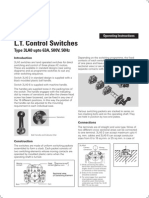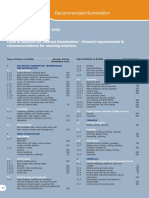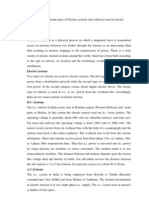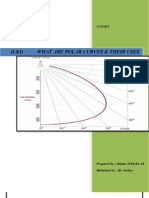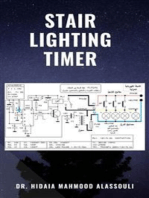LED Lighting Presentation
LED Lighting Presentation
Uploaded by
Anonymous bau06xStTCopyright:
Available Formats
LED Lighting Presentation
LED Lighting Presentation
Uploaded by
Anonymous bau06xStTCopyright
Available Formats
Share this document
Did you find this document useful?
Is this content inappropriate?
Copyright:
Available Formats
LED Lighting Presentation
LED Lighting Presentation
Uploaded by
Anonymous bau06xStTCopyright:
Available Formats
Richard Corbett
Mob: 07805381429
Email:
LED Lighting Training Program
Product Theory
What is LED Technology?
Types of LED Technology available
Driver Technology
Benefits of LED Lighting
Demonstration of different types of
LED Product
Lighting Surveys Key Points we
Look out for
Questions and Answers
LED Lighting Principals
What is LED Technology?
LED Stands for Light Emitting Diode. It is a semiconductor
device that emits light when a current is passed through
it.
LED technology is constantly evolving and found in a wide
range of products in our everyday life. Typical
applications over the years have been household
appliances, telecommunications, signal technologies and
indicator devices, more recently white LEDs have allowed
the technology to become a very efficient modern light
source.
The development of White LED technology progresses at a
rapid pace, the efficiency is constantly improving, quality
of the light and colour of light also constantly improve.
Consequently new applications for LED Lighting open up
on a daily basis.
Types of LED Technology
There are two major electrical components within a LED luminaire.
1
LED Light Engine
2
Driver
LED Light Engines are available in a number of different packages,
we use the following in our LED luminaires
1
SMD LED Packages
SMD Stands for Surface Mounted Device, it is a very small LED
package that is soldered and mounted directly to a PCB (Printed
Circuit Board). This makes the technology ideal for edge lighting LED
panels and for the LED Tubes. We utilise a large number of small
LEDs to ensure uniformity of light, with no light hot (bright) spots.
COB LED Packages
COB Stands for Chip On Board, these compact high flux density light
sources deliver uniform high quality illumination without pixilation or
the multiple shadow effect caused by LED component based
solutions, enabling both diffused and directional lamp replacements
for a wide range of applications.
LED Driver Types
There are various types of LED Driver that we can use, the LED driver is used to control
how the LED light source is operated. These are split into two main categories.
Fixed Output Drivers
These Drivers convert the incoming mains supply into the correct voltage and current for the
LED array. They are fixed output which means they switch on and off only, without any
dimming functionality.
Dimmable LED Drivers
Dimmable drivers are available to allow us to control and dim the LED light source, there are 4
main types of dimmable driver that a commonly used in the UK.
Triac Leading edge or trailing Edge Rotary Dimmable (Traditional dimmer switch)
1 -10V Analogue Dimmable, the dimmable signal is sent to the LED light fitting on a low
voltage communication line. The signal if at 1V sets the dimming level at 10%, if at 5V the
level is set at 50% and at 10V the level is set at 100% etc.
Switch Dim - The Dimming Level is controlled by a push to make switch on the switch live
circuit.
DALI Stands for Digital Addressable Lighting Interface, it is an addressable protocol that has
been set out by a number of major manufacturers to allow compatibility of different
manufacturers luminaires on a single DALI system. The advantage of an addressable lighting
system is that each luminaire is given a unique address . These luminaires are then able to
be monitored and controlled from a central source. Either Scene Select plates or computers.
Benefits of LED Lighting
LED Lighting Systems provide significant savings,
typically the energy reduction on a lighting circuit can
exceed 50%
LED lighting has an average life span of 50,000 hours
with minimal Lumen Depreciation. This means the
output of the LED does not deteriorate with time.
Therefore giving a maintenance free lighting system
and heavily reduced maintenance and re-lamping costs.
LED Lighting provides instant full output light, unlike
fluorescent and Discharge lighting that takes time to
warm up to full light output
LED Technology is not susceptible to switching cycles
and does not deteriorate when switched constantly.
This above two key points mean that the LED Lighting is
the perfect technology to be used in conjunction with
lighting controls.
LED Product Range and Benefits
Panels and
down lights
LED
Surface
Luminaires
Flood Lights for domestic
and commercial applications
T8 Retrofit Tubes
and Fittings
High efficiency
high bay fittings
Lighting Survey offer
When we survey an existing lighting installation,
we look at:
What is the area used for?
What is the Current Emergency Lighting
System
Is the work that we will carry out going to
effect the current system?
Age and condition of existing lighting?
Type of luminaire?
Wattage and type of lamps and control gear?
Condition of the area clean/dirty?
What is the clients main objective?
Energy saving or increase in quality of Light?
Thank you for
listening.
Question
and
Richard Corbett
Mob: 07805381429
Answers.
Email:
You might also like
- Dodge Ram 2005 Factory Service Repair ManualDocument20 pagesDodge Ram 2005 Factory Service Repair Manualsteven100% (62)
- 8202-25 l2 Plumbing Exam Guide v1-0-PDF - AshxDocument15 pages8202-25 l2 Plumbing Exam Guide v1-0-PDF - Ashxedwuinhr herreraNo ratings yet
- SolaX Power Troubleshooting X3 Hybrid PDFDocument16 pagesSolaX Power Troubleshooting X3 Hybrid PDFmarketingsunfix sunfixNo ratings yet
- Practical Guide to International Standardization for Electrical Engineers: Impact on Smart Grid and e-Mobility MarketsFrom EverandPractical Guide to International Standardization for Electrical Engineers: Impact on Smart Grid and e-Mobility MarketsNo ratings yet
- 3 Phase Notes - 2Document4 pages3 Phase Notes - 2Anonymous bau06xStT67% (6)
- Panto EntanglementDocument16 pagesPanto EntanglementAnonymous bau06xStT100% (1)
- Killer TechnologyDocument2 pagesKiller TechnologyJuan Carlos VinascoNo ratings yet
- Displaying The Orient, Zeynep CelikDocument220 pagesDisplaying The Orient, Zeynep CelikIndija BellaNo ratings yet
- LED Street LightingDocument36 pagesLED Street LightingenochsandysandyNo ratings yet
- BJT Biasing (Complete)Document64 pagesBJT Biasing (Complete)Hung PhamNo ratings yet
- Why Transformer Does Not Rotate Like Induction MotorDocument4 pagesWhy Transformer Does Not Rotate Like Induction MotorZulfiker HeiderNo ratings yet
- Branch Circuits and FeedersDocument28 pagesBranch Circuits and FeedersgteklayNo ratings yet
- AC To DC Power Conversion IEEEDocument40 pagesAC To DC Power Conversion IEEEvthiyagainNo ratings yet
- Overcurrent ProtectnDocument18 pagesOvercurrent ProtectnBiruk OlumaNo ratings yet
- Technical Specification - Surge Arresters SPD TypeDocument5 pagesTechnical Specification - Surge Arresters SPD TypeVladimir ĐorđevićNo ratings yet
- Wiring & Protection: by Ryan MayfieldDocument2 pagesWiring & Protection: by Ryan MayfielddhaakchikNo ratings yet
- HarmonicsDocument6 pagesHarmonicsBryan SalamatNo ratings yet
- Pool Control ManualDocument12 pagesPool Control ManualAgung SedayuNo ratings yet
- About Kia Motors Corporation: The All-NewDocument16 pagesAbout Kia Motors Corporation: The All-NewDocMasterNo ratings yet
- 3LA0 Upto 63A, 500V, 50Hz PDFDocument4 pages3LA0 Upto 63A, 500V, 50Hz PDFRaj ChavanNo ratings yet
- Sawdust in Service PanelDocument8 pagesSawdust in Service PanelAhmad YaseenNo ratings yet
- Module 1: DC Circuits and AC CircuitsDocument35 pagesModule 1: DC Circuits and AC CircuitsSRIRAM RNo ratings yet
- Sesi Member DetailsDocument8 pagesSesi Member DetailspvgupthasNo ratings yet
- Isolation Transformer 10882762Document3 pagesIsolation Transformer 10882762Mehrshad SadighniaNo ratings yet
- Recommended Illumination: As Per IS 3646 (Part 1) : 1992Document6 pagesRecommended Illumination: As Per IS 3646 (Part 1) : 1992Abil RajanNo ratings yet
- CAD Line StylesDocument39 pagesCAD Line Stylesaushad3mNo ratings yet
- Plumbing Newbie Tips and Tricks That You Should Knowojiko PDFDocument3 pagesPlumbing Newbie Tips and Tricks That You Should Knowojiko PDFyildirim66lundbergNo ratings yet
- Panel BoardsDocument14 pagesPanel Boardscharlotte anneNo ratings yet
- Engineering VocabularyDocument8 pagesEngineering VocabularyJoaquim Sabino PessoaNo ratings yet
- Switch Gear: Types of Switch GearsDocument6 pagesSwitch Gear: Types of Switch GearsAdeel Mustafa100% (1)
- What Is Maximum Demand?Document2 pagesWhat Is Maximum Demand?bigshan863No ratings yet
- Root Locus TechniqueDocument43 pagesRoot Locus TechniqueAzeem SarwarNo ratings yet
- Expt No.6 Electric TractionDocument7 pagesExpt No.6 Electric TractionPriyanka MauryaNo ratings yet
- Development of Electric Drives in Light Rail Transit (LRT) SystemDocument31 pagesDevelopment of Electric Drives in Light Rail Transit (LRT) SystemArjun Pratap Singh100% (1)
- Industrial Electrical SystemDocument18 pagesIndustrial Electrical SystemH2SO4No ratings yet
- Jones Chopper Circuit DiagramDocument12 pagesJones Chopper Circuit DiagramAniket LikharNo ratings yet
- Swa Cables - Bs5467Document5 pagesSwa Cables - Bs5467IppiNo ratings yet
- There Are 3 Key Elements To A ContactorDocument3 pagesThere Are 3 Key Elements To A ContactorSharath KotaNo ratings yet
- 2.characteristics of A Typical Power System LoadDocument3 pages2.characteristics of A Typical Power System Loadarjuna4306No ratings yet
- Polar CurvesDocument3 pagesPolar Curvesصائمہ باسط0% (1)
- Types of Display Devices Used in Digital CircuitDocument4 pagesTypes of Display Devices Used in Digital CircuitchouguleNo ratings yet
- Rectifiers, Inverters & Motors DrivesDocument32 pagesRectifiers, Inverters & Motors DrivesUtkarsh AgrawalNo ratings yet
- Miniature Circuit Breakers (MCB) : Prepared By:savdas AmbaliyaDocument18 pagesMiniature Circuit Breakers (MCB) : Prepared By:savdas Ambaliyapushpzala86No ratings yet
- V6.0-Smart OLED/LED/LCD TV Repair TipsDocument1 pageV6.0-Smart OLED/LED/LCD TV Repair TipsJibon DasNo ratings yet
- Magenetic Chip Collector New 2Document27 pagesMagenetic Chip Collector New 2Hemasundar Reddy JolluNo ratings yet
- RectifierDocument26 pagesRectifierhemnphysic91No ratings yet
- Hager Isolators SwitchesDocument12 pagesHager Isolators SwitchesDhanTimNo ratings yet
- Spec. Hvac 2004 (CPWD)Document7 pagesSpec. Hvac 2004 (CPWD)SALIMNo ratings yet
- Electrical InstallationsDocument48 pagesElectrical InstallationsSyed Muzammil AliNo ratings yet
- Electric Motors: - Classification / TypesDocument24 pagesElectric Motors: - Classification / TypesBholendra ShakarNo ratings yet
- Type of Motors Used in Electic Vechines and There Classfications in PPT ModeDocument19 pagesType of Motors Used in Electic Vechines and There Classfications in PPT Mode21EEB0B65NIKIHIL VINUKONDANo ratings yet
- PLC Sinking and Sourcing ExplainedDocument3 pagesPLC Sinking and Sourcing ExplainedRajesh RajNo ratings yet
- Capacitor Information (PT 2) PDFDocument18 pagesCapacitor Information (PT 2) PDFwillchamNo ratings yet
- Assignment Questions - Part 1Document2 pagesAssignment Questions - Part 1AnupriyaSaxenaNo ratings yet
- Switching Power Supply Circuit Diagram With Explanation: CatalogDocument22 pagesSwitching Power Supply Circuit Diagram With Explanation: Catalogmohammed100% (1)
- Electric TractionDocument135 pagesElectric Tractionadithya ballaji100% (1)
- Electric Earthing and ShockDocument13 pagesElectric Earthing and ShockDIPAK VINAYAK SHIRBHATE100% (2)
- BLDC SPEC - 0021 - 2005 (Rev.2) PDFDocument18 pagesBLDC SPEC - 0021 - 2005 (Rev.2) PDFdivisional electrical enggNo ratings yet
- BCH April 16Document137 pagesBCH April 16Ramachandra SahuNo ratings yet
- Lagos City Polytechnic, IkejaDocument1 pageLagos City Polytechnic, IkejaDobgima LangsiNo ratings yet
- Cseb ReportDocument25 pagesCseb Reportshchan530% (1)
- Medium Voltage TransformersDocument48 pagesMedium Voltage TransformersCai_waiBeioan100% (1)
- Enhancements Revit 2021Document8 pagesEnhancements Revit 2021DardakNo ratings yet
- PROJECT REPORT of LED BULB UNIT PURPOSE OF THE DOCUMENT ThisDocument23 pagesPROJECT REPORT of LED BULB UNIT PURPOSE OF THE DOCUMENT ThisSANDEEP KUMARNo ratings yet
- Milestones of CLW Updated 30-11-17Document5 pagesMilestones of CLW Updated 30-11-17Anonymous bau06xStTNo ratings yet
- Rates of Major ItemsDocument570 pagesRates of Major ItemsAnonymous bau06xStTNo ratings yet
- TC - 27 Tractive Effort Calculation RDSO PDFDocument6 pagesTC - 27 Tractive Effort Calculation RDSO PDFAnonymous bau06xStTNo ratings yet
- Under Gear Safety ItemsDocument4 pagesUnder Gear Safety ItemsAnonymous bau06xStTNo ratings yet
- Solar Powered Water Pumping System: Department of Electrical and Electronics EngineeringDocument20 pagesSolar Powered Water Pumping System: Department of Electrical and Electronics EngineeringAnonymous bau06xStTNo ratings yet
- Eddy Current LossDocument20 pagesEddy Current LossAnonymous bau06xStTNo ratings yet
- Renewable EnergysourceDocument47 pagesRenewable EnergysourceAnonymous bau06xStTNo ratings yet
- Review of Shop Drawings - Steel StructuresDocument7 pagesReview of Shop Drawings - Steel Structuresعزت عبد المنعمNo ratings yet
- BMCC Syllabus Spring 2010Document3 pagesBMCC Syllabus Spring 2010eharte1445No ratings yet
- IBDP English A Paper 1 (Text Types)Document9 pagesIBDP English A Paper 1 (Text Types)Menon HariNo ratings yet
- 10 TPH Palm Oil Production LineDocument52 pages10 TPH Palm Oil Production LineSouleïman CisséNo ratings yet
- Chapter 7 PDFDocument50 pagesChapter 7 PDFRG RAJNo ratings yet
- 04 Jet Mixing Design ApplicationsDocument6 pages04 Jet Mixing Design Applicationslutfi awn100% (1)
- GBI BPV Catalog PDFDocument11 pagesGBI BPV Catalog PDFJitendra BhosaleNo ratings yet
- g5-m2 Student HomeworkDocument76 pagesg5-m2 Student Homeworkapi-297979181No ratings yet
- Theories of The Origin of LanguageDocument2 pagesTheories of The Origin of LanguageAsad Mehmood100% (3)
- Film City Case StudyDocument19 pagesFilm City Case StudyMohit Sharma100% (1)
- Clutch Problems 332Document3 pagesClutch Problems 332Nova April100% (2)
- IMUN Internship - General InformationDocument11 pagesIMUN Internship - General InformationTamim HossenNo ratings yet
- Taller 3 - Sistemas NumericosDocument15 pagesTaller 3 - Sistemas NumericosJulian CamargoNo ratings yet
- Englisch Allgemein Hetronic PDFDocument32 pagesEnglisch Allgemein Hetronic PDFVerona Mamaia100% (1)
- Biomedical Ktu EceDocument34 pagesBiomedical Ktu EceGreeshma RatheeshNo ratings yet
- Hvac - Centralized AC SystemDocument21 pagesHvac - Centralized AC SystemVala Vraj M.No ratings yet
- Physics - FrictionDocument11 pagesPhysics - FrictionJosh, LRTNo ratings yet
- Teaching PlanDocument3 pagesTeaching PlanMira ManoharanNo ratings yet
- Plag - Evaluating The Employee Retention in OrganizationDocument95 pagesPlag - Evaluating The Employee Retention in OrganizationcityNo ratings yet
- Bizhub C3351 - C3851 - C3851FS - DLKM - BT2410957EN - 01Document4 pagesBizhub C3351 - C3851 - C3851FS - DLKM - BT2410957EN - 01johanjbl2905No ratings yet
- Discussion CADCAMDocument3 pagesDiscussion CADCAMAnonymous OyZEvN03MFNo ratings yet
- Newtons Three Laws of MotionDocument1 pageNewtons Three Laws of Motionevan murphyNo ratings yet
- Gunnebo Lifting Standard Shackle No 854: Bow ShacklesDocument1 pageGunnebo Lifting Standard Shackle No 854: Bow ShacklesTito FebriantoNo ratings yet
- BD 31 01Document52 pagesBD 31 01Oriku Abiodun100% (1)
- Creep Behaviour and Rheolo-Gical ModelsDocument6 pagesCreep Behaviour and Rheolo-Gical ModelsRahul LakraNo ratings yet
- SAS Base Programming Practice Exam V9 QuestionsDocument24 pagesSAS Base Programming Practice Exam V9 QuestionssrinivasaraosomuNo ratings yet



















